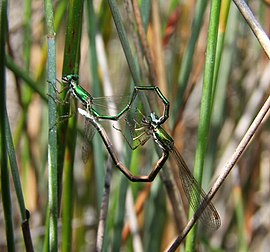Discovery Bay Coastal Park
|
Discovery Bay Coastal Park Victoria |
|
|---|---|
|
IUCN category V (protected landscape/seascape)
|
|

Ancient Greenling (damselfly)
|
|
| Nearest town or city | Portland and Mount Gambier |
| Coordinates | 38°10′S 141°14′E / 38.167°S 141.233°ECoordinates: 38°10′S 141°14′E / 38.167°S 141.233°E |
| Established | 1979 |
| Area | 104.6 km2 (40.4 sq mi) |
| Managing authorities | Parks Victoria |
| Website | Discovery Bay Coastal Park |
| See also | Protected areas of Victoria |
The Discovery Bay Coastal Park is a linear protected area of coastal land in western Victoria, south-eastern Australia. The 10,460-hectare (25,800-acre) park extends along the coast of Discovery Bay from Cape Nelson north-westwards for 50 kilometres (31 mi) to the border with South Australia. The park was listed on Australia’s now-defunct Register of the National Estate, and lies within the traditional lands of the Gunditjmara people.
Part of the course of the Great South West Walk is located within the park. The Discovery Bay Marine National Park adjoins the park to the west of Cape Bridgewater
After being recommended as a coastal reserve in 1973 by Victoria’s Land Conservation Council, the park was first included in Schedule 3 of the Victorian National Parks Act in 1979, with an area of 84.5 square kilometres (32.6 sq mi). Additional parcels of land were acquired in 1981, 1987 and 1997.
Geologically the area is basalt overlain by limestone with the coastal landforms characterised by the rugged cliffs and headlands of Cape Nelson and Cape Bridgewater, dunefields, and by swamps and freshwater lakes further inland. The limestone contains mammalian fossil deposits of age.
Some 320 native vascular plant species have been recorded in the park. An important wetland is Long Swamp, fed by a groundwater aquifer, where declining water levels have led to encroachment by bare twig-sedge (Baumea sp.) whose seeds are a favoured food of the ground parrot. As water levels continue to decline, Woolly Tea-tree is beginning to colonise formerly sedge-dominated areas. The swamp’s sedge habitat is also an important site for an endangered damselfly, the ancient greenling.
...
Wikipedia

